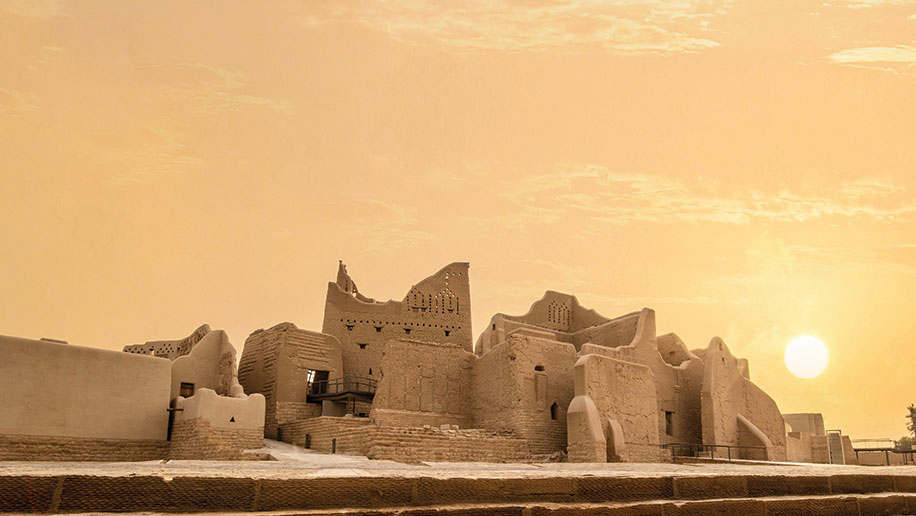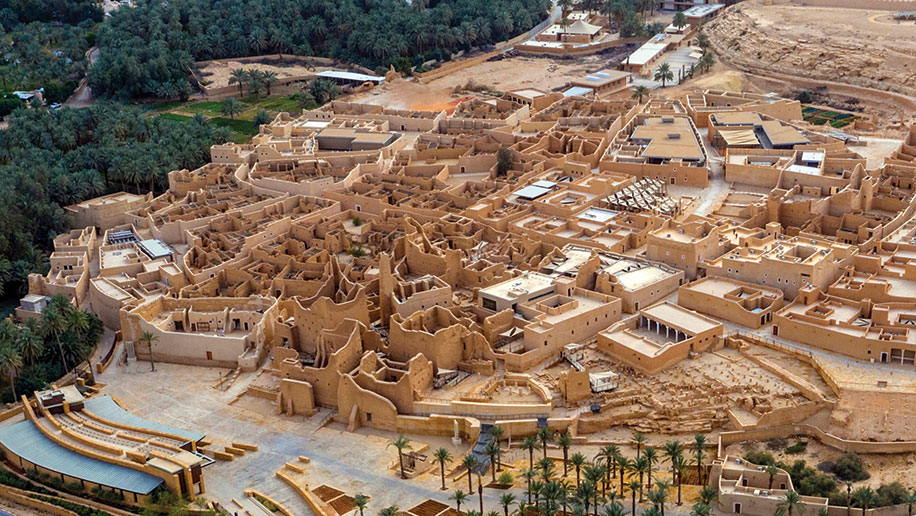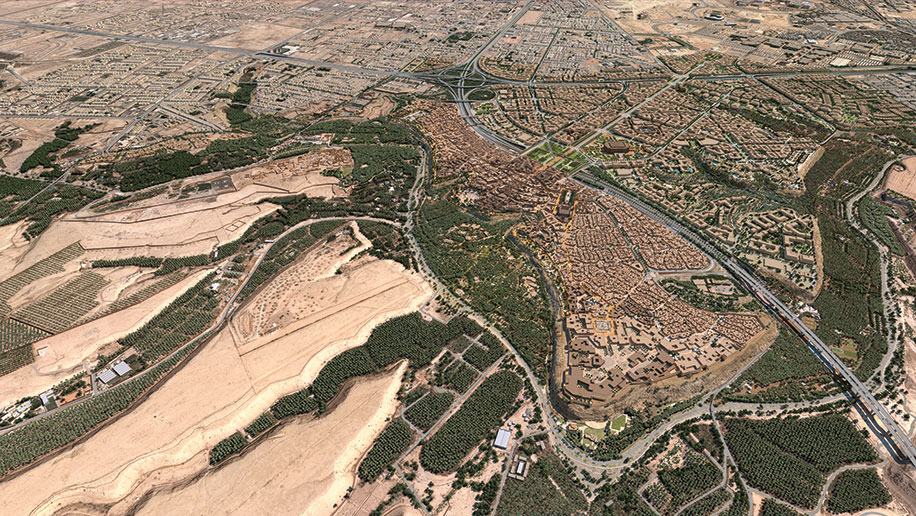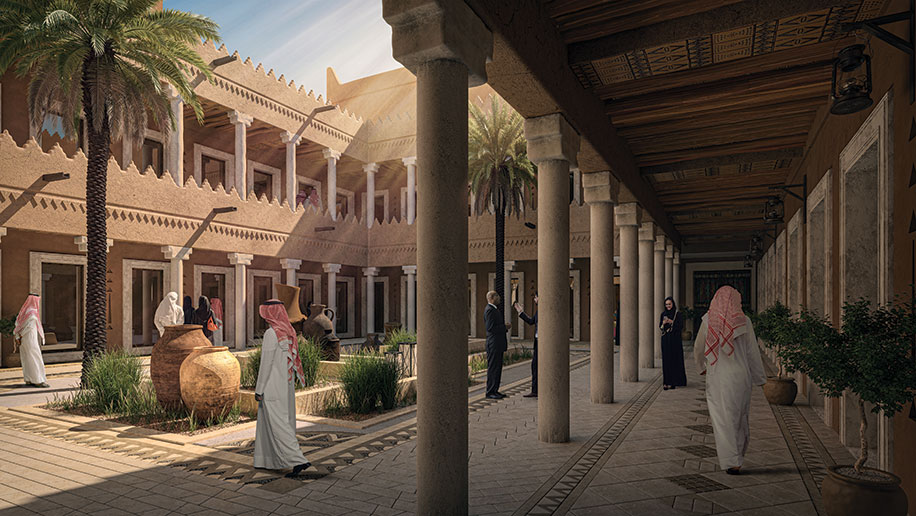
When the First Saudi State was founded in 1727, it was known as the Emirate of Diriyah. It extended across the entirety of present-day Saudi Arabia and derived its name from its capital located on the outskirts of Riyadh. It was the ultimate seat of power in the Arab world. Wind the clock forward nearly three centuries to Saudi Arabia today, and Riyadh is now the capital of a country that not only has the world’s largest Arab economy, but is also a G20 member state. Riyadh is an economic nerve centre in the region – and one with untethered ambitions.
Saudi Arabia’s Crown Prince Mohammed bin Salman bin Abdulaziz Al Saud has stated that he intends to transform Riyadh into one of the world’s top ten city-economies. To get there, plans are being drawn up for the kingdom to spend US$220 billion to transform the city and double its resident population from the current figure of approximately seven million people over the next decade. To augment that strategy, it is undertaking the construction of mega development projects.

One of them is the US$50.6 billion mixed-use development at Diriyah on the outskirts of Riyadh. Diriyah features the UNESCO World Heritage site of the mud-brick-walled At-Turaif District which was the former capital of the Emirate of Diriyah and also home to the royal family that ruled the First Saudi State – a direct lineage can be traced to the current-day ruler of the kingdom, King Salman bin Abdulaziz Al Saud.
The Diriyah project was first announced in 2017 and the current development is spread over 14sq km. It is being developed in three phases – Diriyah Gate 1 (DG1), Diriyah Gate 2 (DG2) and Diriyah Gate 3 (DG3). Business Traveller Middle East was recently given exclusive access to view its masterplan at the headquarters of the Diriyah Gate Development Authority (DGDA) in Riyadh.
At present, work is underway on DG1, the northern side of which is being built with a focus on Saudi culture and heritage and will have a total of 24 cultural assets. Meanwhile, the southern wing of DG1 will feature 1,600 residential assets which will house up to 6,000 residents. All the residential, hospitality, and cultural assets being built in DG1 will adhere to the Najdi mud-brick style of architecture that blends seamlessly with the adjacent At-Turaif District. Over 180 million mud bricks have already been made for the project – for scale, if you were to line them up, it would be 3.7 times the length of the Great Wall of China.
“It will be the world’s largest mud-brick city, designed in the Najdi architectural style native to the region and using traditional construction methods and materials where possible. This grounds the project in Diriyah’s history and ensures that we are authentically paying tribute to this 300-year-old city. Diriyah never has and never will be just another destination near Riyadh,” explains Jerry Inzerillo, group chief executive officer at DGDA.
Along the outer perimeter of Diriyah is the sprawling Wadi Hanifah with its lush landscape of palm trees – for perspective, it is about double the size of Hyde Park, and half the size of Central Park. By virtue of a royal decree, not a single palm tree in Wadi Hanifah can be felled at any stage over the course of the area’s development.

Welcoming the world
Diriyah is forecast to host 27 million visitors annually by 2030. To meet those numbers, its hospitality offerings will be key. There will be a total of 38 hotels across the entire project. However, 18 will open in the first phase – 14 in Diriyah and four in the nearby area of Wadi Safar.
It includes names from around the world including UAE-based Emaar Hospitality Group’s Address Hotels and Resorts, New York’s Baccarat Hotels & Resorts, and a Milan-born Armani Hotel – only the third Armani property in the world. Marriott will be bringing its Ritz-Carlton and The Luxury Collection – the latter of which will be the first hotel to open in Diriyah next year. Accor will be present in Diriyah with its Raffles and Orient Express brand – it will be the first Orient Express property within the Middle East. Besides, Rosewood which was previously in Riyadh and exited the city, will now return with a presence in Diriyah, while the Four Seasons which sits in an iconic structure in the centre of Riyadh has also confirmed that it will open only its second hotel in the kingdom here.
Imran Changezi, senior director of Business Development for Hospitality at DGDA, was responsible for onboarding the hotels in a process that he says was expedited by the sheer interest of hotel operators to be a part of the new development. “In July 2020, we gave operators only two weeks to consider and reply to our request for proposals. We got a 100 per cent response rate – that’s how interested the market was in this project. By September, we had signed MoUs with all 18 operators.
“Each hotel pays tribute to the Najdi architecture, but no two will look alike. This is where the design competition that we organised came in handy. We engaged over 34 design consultancies from around the world and they churned out renderings and designs keeping in mind the hotel’s location within the project and the unique vision of each hotel,” notes Changezi. Some of the architects working on the Diriyah project across its different assets include Aedas, Killa Design, OBMI, Rockwell, Oppenheim Architecture and Denniston, among others.
Changezi says that collectively, the first 18 hotels will add around 6,500 keys to Riyadh – a market that currently has around 18,000-19,000 keys, only 10 per cent of which are luxury keys. With a plan to attract over 42 million visitors to Riyadh by 2030, the local hotel market is a long way out from being saturated.

One of the first hospitality assets to open this year itself is not a hotel but instead the 15,000 sqm Bujairi Terrace dining district in Diriyah which is located on a terrace that offers commanding views of the Wadi Hanifah and the nearby At-Turaif site.
Bujairi Terrace aims to attract seven million visitors annually to this dining hotspot, which includes some of the most sought-after restaurants from around the world – many of them are in Saudi and the wider region itself for the very first time. Hakkasan enters Saudi for the first time, while Café de L’Esplanade is opening only its second brand in the world outside of Paris in Diriyah. There are a total of 20 restaurants opening initially in Bujairi Terrace which range from fine-dining, and all-day cafès to casual-premium offerings. Michelin-starred restaurants including Bruno, Long Chim and Tatel will also be a part of the mix, as well as Saudi homegrown brands such as Takya and Sum + Things. Interestingly, the space will also feature Saudi Arabia’s first food hall with the list of brands due to be announced soon.

The big dig
Nicknamed ‘The Big Dig’, there’s a 30-metre-deep hole being dug in Diriyah with over seven million cubic metres of sand being excavated in the process. All the modes of transportation and infrastructure to support it – metro lines, roads, tunnels and parking bays – are strictly subterranean within Diriyah which is conceived as a pedestrian-only zone overground.
The excavated sand is taken to a site nearby where it is processed, and around 40 per cent of it reused as backfill for the site itself. A portion of the remaining sand is sent to other projects under construction around Riyadh.
The logistics of building a mega project at this scale requires some mighty planning – not least of which was the construction of a temporary highway to divert traffic away from the construction site. In October last year, in just 63 days, DGDA built a parallel 3km stretch of an eight-lane highway along the southern ring of Diriyah and diverted traffic to it without a single road closure over the period.
Creating a complex subterranean network requires significant engineering feats. In January this year, the DGDA awarded a US$1.06 billion contract to Salini Saudi Arabia to create what is being referred to as a “Super Basement” car park. That one million sqm Super Basement is being built across three levels below Diriyah Square – in the centre of DG1 – and will accommodate 10,000 cars. Eventually, Diriyah will have parking bays for 24,000 cars.
DGDA’s chief marketing officer, Kiran Haslam, says that the Super Basement offers more than just a glimpse of the engineering wizardry of the project, and is more along the lines of serving a grander vision of the project. “Building that car park three levels down is a technological marvel, but what we’re actually trying to achieve with Diriyah is to consider how can we bring a population cohesively together as a quality of life proposition. The proposition of life in Diriyah is pedestrian, and the complexity of life for Diriyah is made human scale. If you go to a pedestrian-friendly city like Barcelona or one in a Scandinavian country, you have that opportunity for a true cultural exchange and interaction while you walk through the city. Diriyah looks onto Riyadh city in exactly the same kind of context as Greenwich Village does to New York City. It’s brilliant how His Royal Highness could see that concept so early on and connect Diriyah’s quality of life proposition with Vision 2030,” says Haslam.

While the private sector is being courted to participate in different aspects of this mixed-use project, the majority of the ownership of the assets in DG1 will lie with DGDA. As Talal Kensara, chief strategic officer at DGDA explains, there are five main asset classes across Diriyah where the private sector’s participation can be defined: culture and heritage, hospitality, retail, education and the proposition of ‘live and work’.
“When it comes to culture and heritage, we’re creating opportunities for the private sector to engage in this asset class in the future, but for the moment we are relying on the government and its departments such as the Ministry of Culture. With regards to hospitality, with DG1 we have decided that we will own most of the hospitality assets. However, within DG2 and DG3 we are open to working with investors to build the real estate for it and find the right operator.
“As for retail, we don’t have the concept of malls at Diriyah. In DG1, we will own all the retail outlets and allow retailers to lease the spaces. But because we are open to private sector investors in DG2, that is where they can actually own the whole building and start selling in it or lease it to big retailers, but always in accordance with our strategy.
“The ownership of assets for education meanwhile will follow the same principle as that of our heritage and cultural assets, with the exception being K-12 education where the private sector can own as well as operate their assets. Our residential strategy is one that will align 100 per cent with the private sector. At present, we are in the process of striking joint venture agreements between DGDA and real estate developers,” explains Kensara.

Saudi first
Diriyah is ensuring that the ripple benefits of the project are felt first and foremost within the kingdom. “Success will be realised once Diriyah adds around US$7.2 billion to the kingdom’s GDP, creates 55,000 jobs, and attracts upwards of 27 million visitors a year,” says DGDA’s group CEO Inzerillo. “As one of the first destination projects to open, we are key to the kingdom’s Vision 2030 pledge to increase tourism’s contribution to the country’s GDP from three per cent to ten per cent.” He adds that as part of the Saudisation process, 85 per cent of the staff working for DGDA are Saudi nationals. Also, a deliberate process is being made to ensure that women are well represented within the workforce. “Vision 2030 [has] pledged to increase female employment from 22 per cent to 30 per cent. We are already ahead of the curve, with 36 per cent of our staff being women, and 16 per cent of them holding management roles.”
Apart from ensuring that its workforce includes mainly Saudi nationals, the target audience that this is being marketed to is also focused within the kingdom. “It will always be kingdom first. DGDA has a supervisory area of 194 sq km. We will have hundreds of thousands of people that are living, going to work and school, and going about their daily lives every day in Diriyah. We first need to look after our family – and from that, we do everything else. So [our target audience] is a kingdom-first approach, and we will then focus on the GCC market, followed by the rest of the world,” says Haslam.
The development of Diriyah is deeply respectful of the historical significance of the area. There are barriers placed along the length of The Big Dig to ensure at least ten metres of separation between the construction site from the remains of the original mud wall that made up the perimeter of the original At-Turaif District. Sensors placed on the centuries-old mud walls monitor seismic activity and forewarn the teams if there is a risk of it collapsing as a result of the nearby construction work.
Before an excavator can enter any part of the terrain and get to work, a special heritage team from DGDA is on-site to inspect whether there are any archaeologically significant remains in that particular spot. Understanding the historical significance of the area and furthering that narrative is the work of Adam Wilkinson, chief of heritage and culture at DGDA. “In my 20 years of working in conservation and heritage, it’s always been heritage versus development. Here at Diriyah, that’s not the case. Let’s say we find a piece of archaeology in a location where a road was planned. That road is moved, and that then changes how you perceive the place in the future and how you use it,” says Wilkinson. During our site drive around The Big Dig, we’re shown an area around the southern flank of DG1 where the team found a well and a grave. That specific area will be preserved and construction will continue around it.
Around 40 per cent of the At-Turaif District will be opened to the public this year. Conserving a nearly 300-year-old site, that uses bricks that date back to a quarter-of-a-million years throws up several challenges. “It requires us to step out of a Western mindset to conservation. In the West, we’re used to dealing with stone, bricks and timber. Here, you’re dealing with mud. Mud is delicate, decays quickly and needs constant maintenance,” says Wilkinson. Conservation of the remaining areas of At-Turaif will continue over the next few years. “It will give us a chance to understand more about the origins of At-Turaif. At the same time, we’re doing archaeology work in the wadi agricultural areas and will soon start in Ghasiba too which is one of the earliest settlements in this area,” notes Wilkinson.
Construction of DG1 is on in earnest and one of the biggest highlights will be a new mosque which will be one of the biggest mosques in the world. Saudi Arabia’s Ministry of Culture will relocate its headquarters to Diriyah too. DG2 will feature attractions such as a dedicated Saudi museum of culture and arts. The masterplan for DG3 is in the final stages of preparation. Construction on the different stages of the project will continue until 2030.
With several other mega projects coming up not just around Riyadh, but in other parts of the country too, Kensara says that there is an ongoing engagement with them to ensure that there is no cannibalisation of asset offerings. These projects are achieving this by way of opening up individual destination management offices – Diriyah has set up its own too – through which there will be a coordinated effort to study how tourists can be encouraged to travel from one destination to another.
Ultimately, the positioning of Diriyah is of becoming one of the world’s largest cultural and heritage destinations and is not as much a nostalgic look into its past, as it is a peek into the kingdom’s exciting future. As Inzerillo says, “Diriyah carries with it an immense historical legacy and is one of the most important symbols of Saudi heritage and identity. Our mission is to re-centre Diriyah on the global map as a crossroads of culture, arts, science and commerce through a range of initiatives, including tourism. The purpose of Diriyah, as a cornerstone project of Vision 2030, is to ensure that as Saudi Arabia moves into the future, it anchors itself on the kingdom’s vibrant past.” Those roots run deep.












